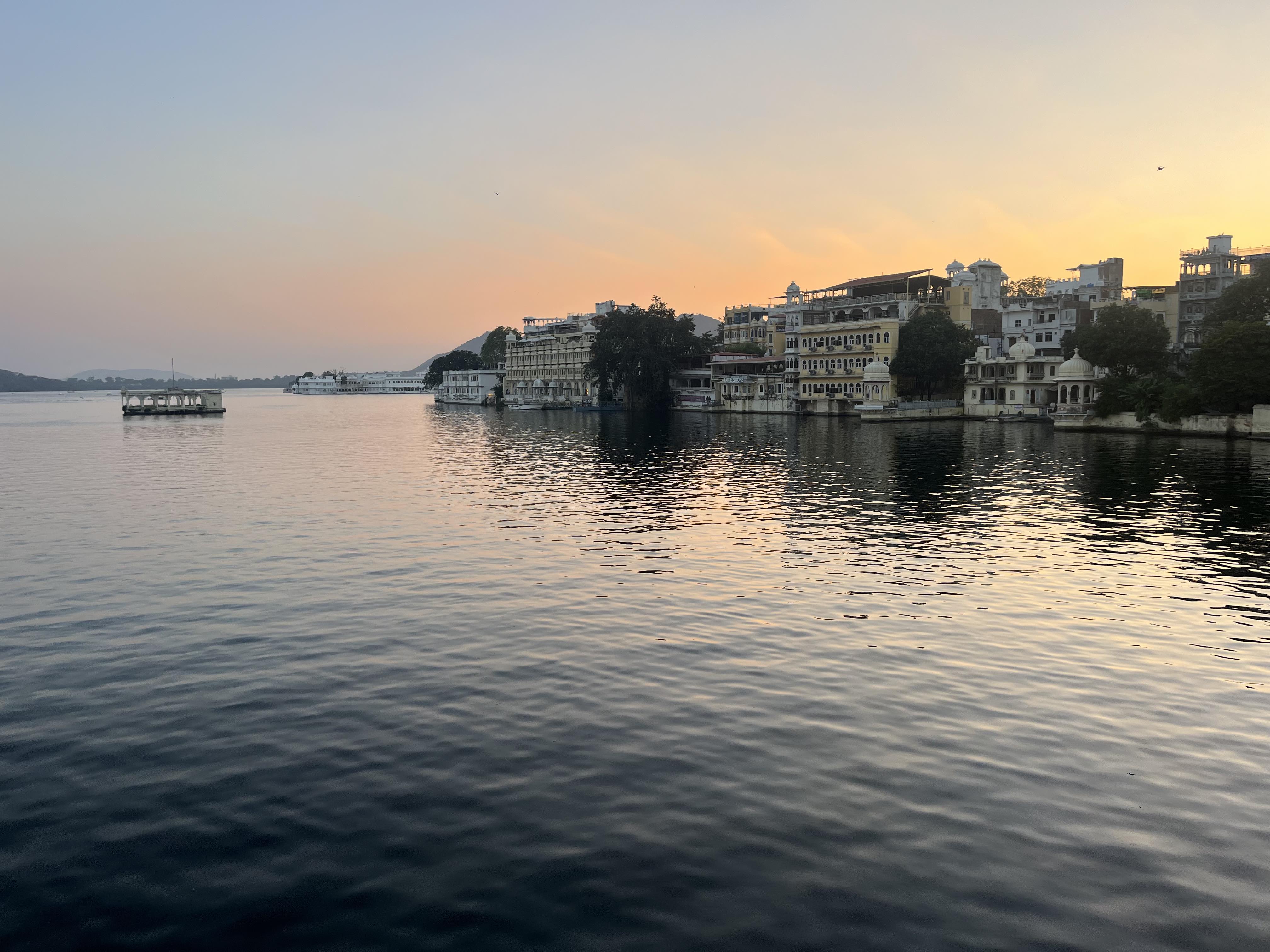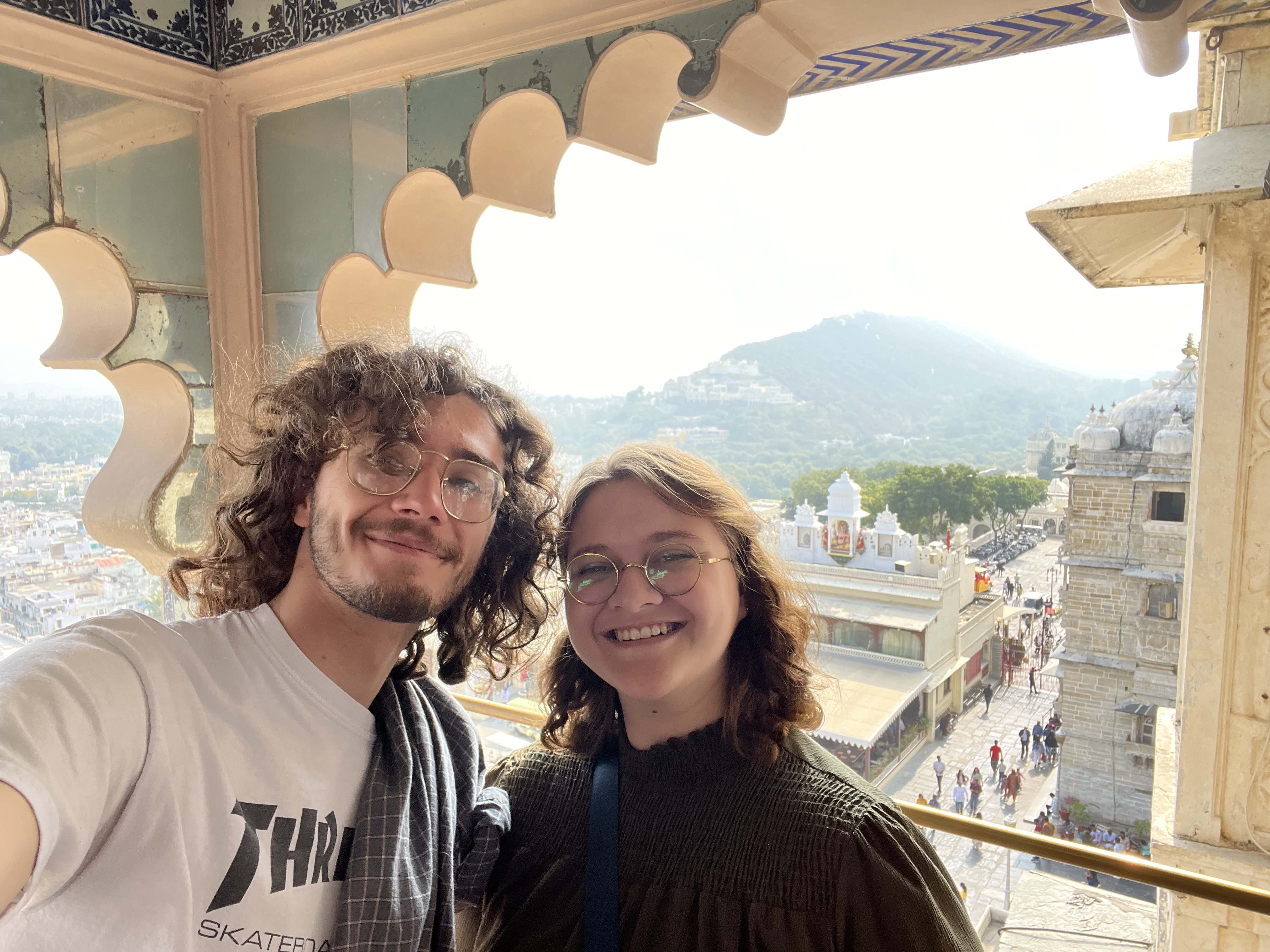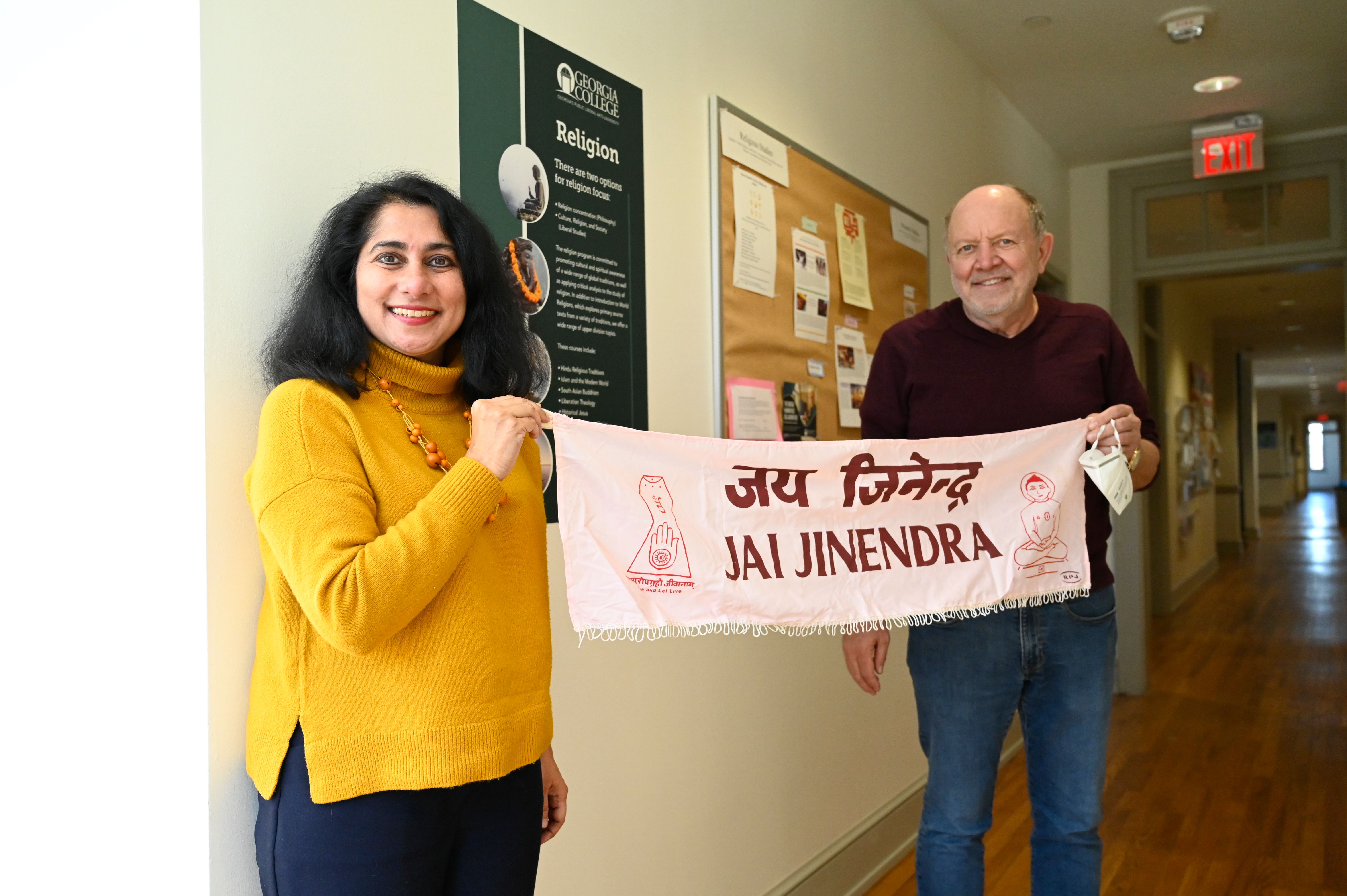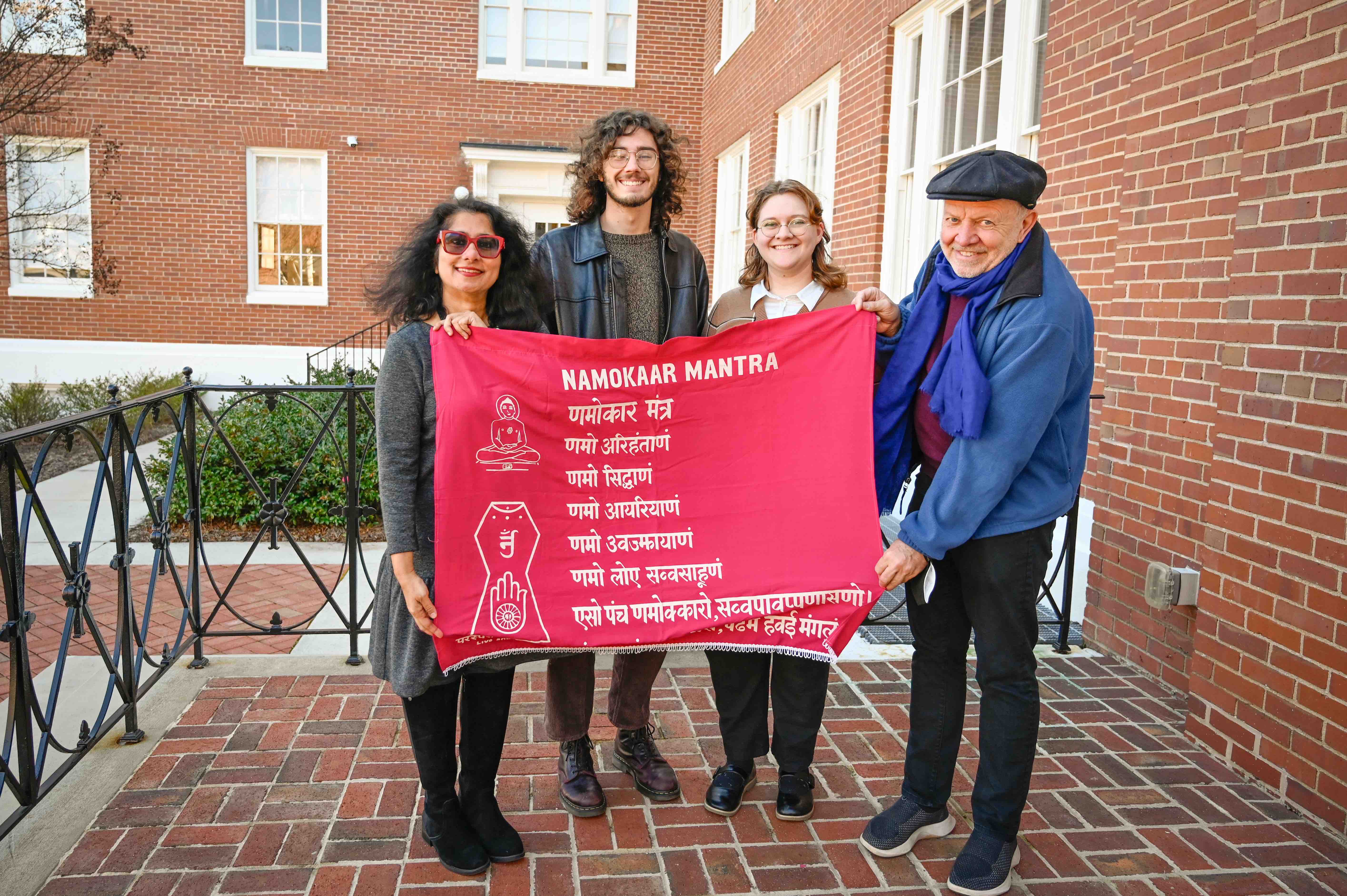Jain Studies students see the great and ancient temples of India
A fter traveling 24 hours by plane and a motorized rickshaw ride through the twisting streets of Udaipur, India, to their ‘haveli’ (hotel)—a mansion several centuries old—two Georgia College & State University students were exhausted and barely able to keep their eyes open.
Although they hadn’t eaten, they said they just wanted to go to bed and sleep.
Trudging to their rooms, the students looked out at the stunning city—the “Venice of India”—emerging from the serenity of a lake. All of a sudden their eyes popped wide open, the surreal beauty reigniting their adrenaline.

“I was in India already. So, I joined them in the city. They had just flown in, and the two students looked very tired,” said Dr. Sunita Manian, chair of Georgia College’s Department of Philosophy, Religion and Liberal Studies (PALS).
“Oh my goodness, they’re probably thinking this was a huge mistake,” Manian said. “But when checking into our hotel and they see the view of the lake, they perked up and were ready to go to dinner. Seeing the difference by how tired they looked and then how excited they were—it was very rewarding.”
After that, the students—Liam Landry of Athens, Georgia, and Basil Cooper of Suwanee, Georgia—couldn’t wait to soak everything in.

The trip was paid through generous donations from the Jain community and university grants.
The group didn’t waste one minute on the journey, which took them on breathtaking excursions to see temples, art, caves and architecture in seven Indian cities.
It was all part of a new position at Georgia College, the “S & R Palvia Endowed Veetraag Vigyaan Professorship in Jain Studies.” The endowment was established in fall 2023, funded by a $250,000 gift from Dr. Shailendra and Rajkumari Palvia, who live in Atlanta.
It’s the only Jain professorship in Georgia and one of about a dozen across the nation.
An endowed professorship is the highest academic award a university can bestow on a faculty member. Dr. Caley Smith, who holds a Ph.D. from Harvard University, was hired for this position. Since joining Georgia College in Fall '23, Smith has been teaching students more about this less-known Indian religion by incorporating Jain perspectives into courses.
Jainism is one of the world’s most ancient religions, slightly older than Buddhism.
There are about 33 million gods and goddesses in India, many of them Hindu. But there are no gods in Jainism. People go to Jain temples to learn about the great thinkers and contemplate how they lived their lives.
Jains are non-violent and believe in reincarnation. There is no process for converting to Jainism. Still, people can adopt the Jain way of life—eating vegetarian and respecting all living things, even the smallest.
“The three key principals of Jainism are of non-violence, non-dogmatism and non-possessiveness,” Winchester said. “Jains think the world would be a better place if more people took those principals seriously. That’s the goal of the professorship—to increase understanding and knowledge of Jainism in the world.”
For Landry and Cooper, classroom lessons became first-hand realities in India.
The group visited Jain temples in Udaipur, known as “the beautiful City of Lakes.” In Verul, India, they toured the Ellora Caves—a massive complex of 34 caverns sculpted in the 7th and 11th centuries. They learned about Jain “tirthankaras” or spiritual teachers, who guide humanity on a path of non-violence and teach of a world without possessiveness where no truth is absolute.
The Ellora Caves are a testament of the blending of Indian religious traditions, Manian said. Some cave temples were Buddhist, others Hindu and four Jain.
The caves were Landry’s favorite site, the largest statues he’s ever seen. The junior is double majoring in mathematics and philosophy. He had seen pictures of places like this in books.
“But nothing compares to being able to see them in person,” he said. “The size of Ranakpur really floors you when you see it with your own eyes. The carvings at Dilwara were probably the most intricate I’ve ever seen.”
The group visited Ranakpur in the evening just before sunset. Double majoring in philosophy and liberal studies with a concentration in religion, Cooper was excited to see India’s great temples up close. The junior is also double minoring in art history and museum science, so the trip was a chance to combine all disciplines into one learning experience.

“Ranakpur feels fairly isolated in the jungle and, at that time of day, there were so few people there that we really got to absorb the atmosphere,” Cooper said. “I’m personally of the opinion that the carvings at several of the major temple sites, such as Dilwara and Ranakpur, are the most exquisite in the world.”
On that first transformative day, Cooper got a new perspective of South Asian religion and culture. It reinforced a desire to get a Ph.D. in South Asian religious studies and continue researching Jainism.
“I was excited to be able to experience a culture and landscape so vastly different from my own,” Cooper said. “Not only this, but I’ve been interested in studying South Asian religions since high school, so the fact that the opportunity to travel came with the research obligation was something I was beyond excited for.”
Being in a small class setting at Georgia College and learning from “phenomenal professors” helped motivate Cooper to explore new ways of thinking.
“Studying South Asian religions in the classroom really pales in comparison to being able to stand in these caves and temples that are over 500 years old, and in some cases over 1,000 years old,” Cooper said. “I felt I was able to truly experience the deep history and culture. The trip has really made me more passionate about my studies.”
Landry enjoyed learning about Jainism too. He plans to go to law school. The trip prepared him for this future by expanding his worldview, giving him a broader knowledge of other cultures and religions.
There were museums, lectures and a visit to the International Schools of Jain Studies in Prune, India. The group also attended a conference hosted by the Institute of Cross-Cultural Studies and Academic Exchange. Landry presented his research on the ways he thinks Buddhism, Jainism and Marxism can contribute to the end of human suffering.
Cooper presented a paper on temple art and architecture in India. Seeing the structures up close and learning about the “austere” religion devoted to non-violence was strikingly different than Western culture. It was a chance to learn “something new” at every turn.
“In the West, it feels like there’s always ongoing war and violence, plus a huge cultural dedication to materialism,” Cooper said. “I wanted to know more about Jain philosophy and how I could better understand a lifestyle away from these things. Spreading an understanding of Jain philosophy could also be incredibly beneficial for propagating a greater understanding and respect for people with different backgrounds and lifestyles.”
In addition to mouth-dropping temple sights, Landry and Cooper also got a taste of Indian cuisine.
At first, Manian said Landry would only eat pizza. But he soon started experimenting and came to love a spicy, black lentil dish call “dal makhani.” Cooper misses a sweet dessert of fried dough, called gulab jamun.

The students appreciated traveling with their professors, who could explain the history, ancient scrolls, rituals and culture.
Manian was born in Calcutta, India, and speaks the Indian languages of Hindi, Bengali and Tamil. The nation has about 300 languages altogether and 560 dialects.
This semester, Landry and Cooper are continuing their study of Jainism by learning Sanskrit, an ancient South Asian language. Most Jain texts are written in Sanskrit, so this will help with their research with Smith, the new endowed professor.
“Overall, honestly, it was amazing,” Landry said. “Everywhere we went was utterly breathtaking.”
